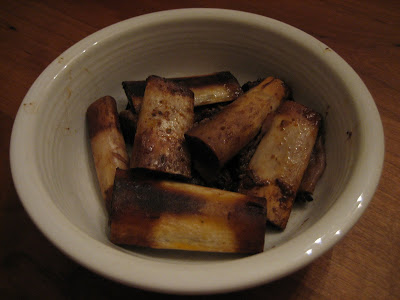My very first cookbook was Madhur Jaffrey's "An Invitation to Indian Cooking", which, in retrospect, was a great starting point for learning to cook.

Indian food tastes pretty good even when made at the hands of someone who doesn't really know how to cook. The abundant spices easily cover up any mis-steps and less-than-pristine ingredients. We were poor starving graduate students at the time and couldn't afford fancy groceries, and, more to the point, were car-less and trapped in a place and in a time that in sum was not particularly known for the variety, availability and quality of produce. In those days, I would choose a recipe to make based on the list of the ingredients. I figured that the longer the list, especially in the form of spices, the better it would come out. I was correct on that point! We had many marvelous meals from that cookbook, which I still own and is tattered and splattered with food residues now. One of my favorite dishes was the lamb korma. Take at look at how long the list of ingredients is!

It was pretty crazy, but because I learnt to cook exclusively from cookbooks, I thought nothing of working 12 hours in the lab, coming home and then making a meal from scratch from one of these recipes. I thought that was how people cooked every day! I suppose, in consequence, we have always eaten very well and deliciously. There was no fast, throw-everything-together sort of cooking at my place. I was making slow food long before it became fashionable!
However, as I have expanded my horizons to other cuisines, moved to Northern California - the birthplace of cooking by doing as little as possible to pristine produce- and, finally, gotten tired of cooking elaborate meals every night, I have come to appreciate the genius of simple recipes that work. The genius in these recipes have their proof in dishes that, because of particular cooking techniques, great ingredients and just the right balance of flavors, taste like something you'd have sworn was a lot more complicated to put together than a brief perusal of the recipe might suggest.
Last night, I discovered just such a gem of a recipe that I plan to make many, many times again. It is from the latest cookbook by
my favorite experts on Moorish food:

This recipe had just 4 ingredients, not counting cooking oil and water, which would have dis-qualified it from consideration 15 years ago.

But I chose it because I wanted to cook out of this cookbook, which was a recent acquisition that I had not previously made use of, and because I thought it would be a good way to use the sumac that my mother-in-law had brought home all the way from Turkey and was kind enough to share with me.
What a treasure I found! It really had all the elements working for it. Great cooking techniques to draw out and build the flavors: chicken was first seared in a pan to crisp the skin and then roasted in the oven; great ingredients: the best, freshest sumac ever straight from a Turkish market and the best pine-nuts ever (Dave called them "grey-market pinenuts" because he'd acquired them from a chef who had personal connections for the most pristine produce); great flavors in the crisp, brown chicken skin and dark meat combined with a great sauce that formed from roasting the chicken drippings with spring onions, sumac and pine nuts.

I made a side dish of green beans with garlicky tomato sauce, fenugreek seeds, fresh red chillis and coriander to go with it. It was from the same cookbook and was quite unusual and delicious.

The whole dinner took less than an hour to make - 10 minutes to sear the chicken and another 20 minutes to roast it, during which I made the beans. Not really fast food, but it was so good you might have thought that it took me much longer to make.
We had a Cline Mourvedre to go with it, which was a little heavy but I thought went well with the sumac in the chicken and the fenugreek in the beans.

Dessert was some of that
marvelous Madeira from our stash that we smuggled back from Portugal.
Here's to discovering more recipe treasures in the future!

























